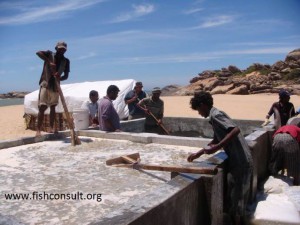Photo credit:Tim Huntington (UK)
Technical review: Abdel Rahman El Gamal (Founder of the website)
This jellyfish resource remains un-utilized for many years until an emerging demand on jellyfish showed up and led to a significant activity in SriLanka within a relatively short time.
In order to meet the increasing demand, the harvesting of jellyfish processed in SriLanka seas in several districts especially the seas of Panama and Komariya, in the Ampara district, and in the Kirinda area in Hambantota district. The jellyfish species for export is caught bulk by fishermen and sent for processing where the preparation for export takes place. It is estimated that more than 100 to 150 tons of jellyfish are processed daily and about 20,000 fishermen make a living from the harvesting of jellyfish. Out of the several species of jellyfish, only two species are suitable for export. The two mentioned are characterized by their seasonal catch that lasts for several weeks every year before being drifted away either to India or the Maldives. This causes putting more fishing pressure on these species in SriLanka at this particular time.
The processing is done by immersing the jellyfish in a mixture of alum and salt to extract their water content resulting in a significant shrinking of processed animals whereas 20 kilograms of raw material will be required to obtain 1 kilogram of processed jelly fish. The processed jellyfish is exported primarily to China as well as some other Asian countries where it is considered a delicacy, as well as an aphrodisiac.
There are different opinions related to the catch of jelly fish for export. The fishery authority finds that this activity provides a work opportunity to about 20,000 men who make living of it and is also essential for increasing the inflow of foreign exchange. Moreover, they see –and after a brief stock assessment- that the jellyfish populations are high and so are not threatened by the jellyfish trade, and claim that the ocean’s jellyfish resources were being over-exploited and hence there is no urgency for imposing controls on the harvesting of jellyfish.
On the other hand, the environmentalists find that the mass harvesting of jellyfish is harmful to the marine environment especially in regard to the survival of certain other marine species that feed on jellyfish. They expressed their concerns about the current exploitation level of this resource without a proper resource assessment of jellyfish within SriLanka waters.
Currently, matters relating to jellyfish are covered by the Fauna and Flora Protection Ordinance that comes under the Director General of the Department of Wildlife Conservation.

